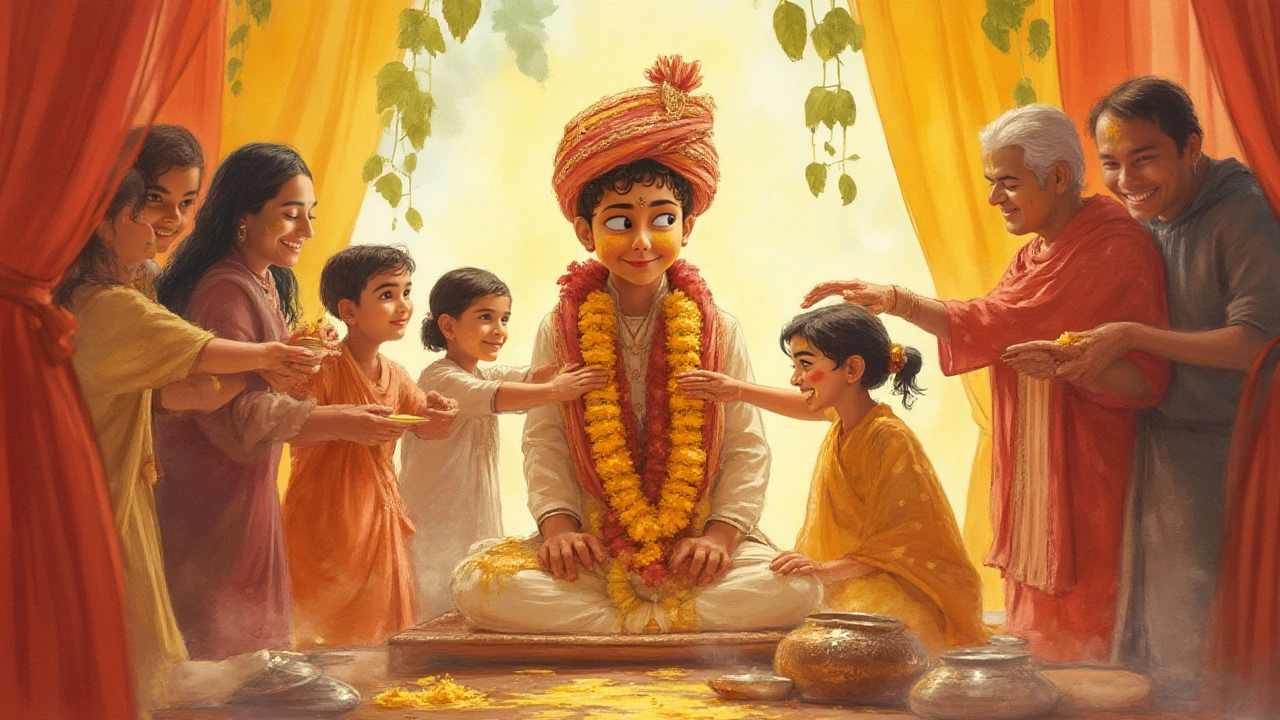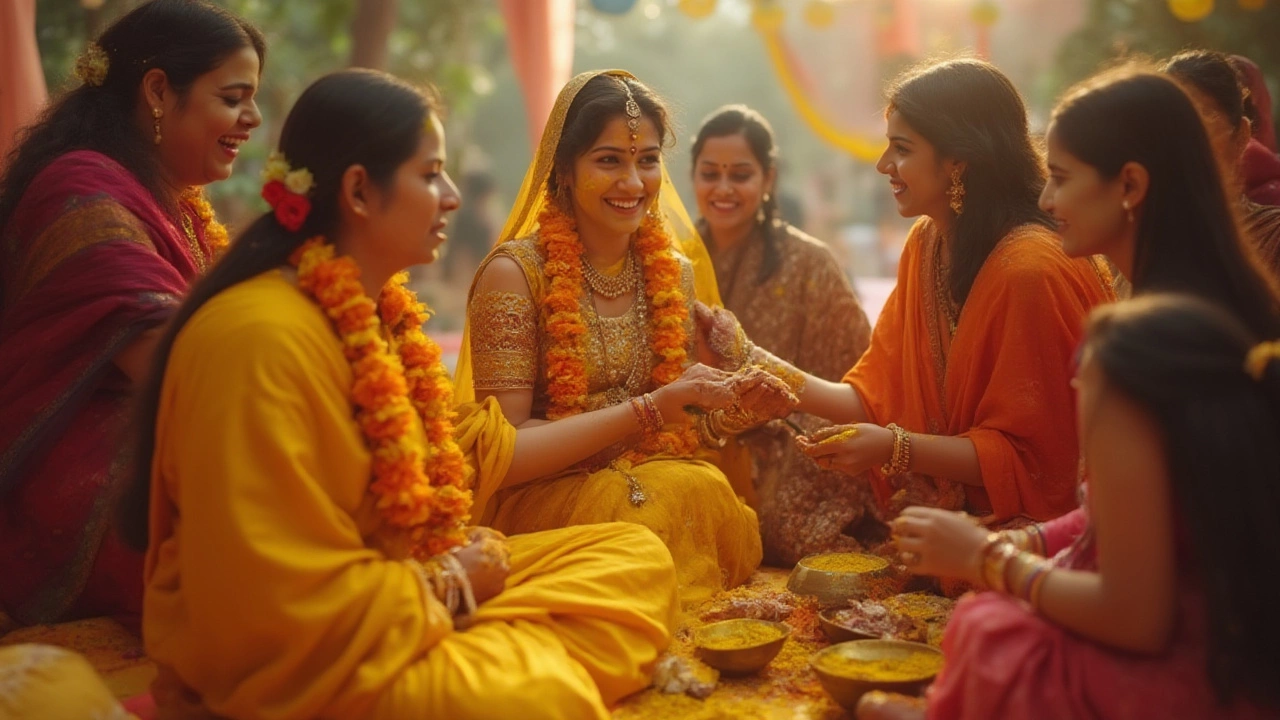Walk into any traditional Indian wedding, and you’ll spot a flash of bright yellow that’s hard to miss. Guests are grinning, relatives are bustling, and somewhere between all that color and chaos, someone is getting smeared head to toe in a golden paste. The whole scene smells faintly of something earthy and spicy, with the air buzzing with laughter and anticipation. It's not paint, and it’s definitely not just for show—this yellow stuff carries centuries of meaning and a bunch of fun along the way. Surprised how much can be packed into a single ritual? You’re about to find out what makes the yellow stuff, known as “haldi,” much more than just a splash of color in Indian weddings.
What’s in the Yellow Paste and Why Is It Everywhere?
If you’re curious about what goes into this eye-catching wedding ritual, you’re not alone. The yellow stuff at Indian weddings is usually a blend of turmeric (called haldi in Hindi), sandalwood powder, rose water, a little oil, and maybe a dash of yogurt or milk. You might have seen Facebook or Instagram flooded with pictures of Indian brides and grooms grinning in their yellow glory—this is the haldi ceremony in full swing.
Why turmeric? The answer goes way beyond color. Turmeric has always been a superstar in Indian kitchens, but it’s also a secret weapon in traditional wellness. It’s praised for being great for your skin, for its antibacterial kick, and for how it brings out a glow that’s pretty much impossible to fake with makeup (no offense to contouring fans). A study published in the Journal of Ethnopharmacology showed turmeric’s active ingredient, curcumin, offers antioxidant and anti-inflammatory benefits. In short, this is genuinely good stuff to slap on before you face giant crowds and a thousand photos at your wedding.
Brides and grooms don’t just do this because grandma says so. The haldi paste is believed to have spiritual and magical properties—it wards off evil, chills nerves, and blesses the couple’s new journey together. Historically, turmeric has been used in rituals across India, not just weddings. You’ll spot it at baby showers, housewarmings, and plenty of religious ceremonies. That’s why haldi isn’t just about skincare or even just about the wedding—it’s about starting a new phase of life in the brightest, healthiest way possible.
The haldi ceremony happens a day or two before the actual wedding. Close friends and family members gather around the bride and groom, prepared with bowls full of yellow turmeric paste. They take turns smearing the paste liberally on the soon-to-be-married couple’s faces, arms, neck, and sometimes even feet. Now, it’s not a gentle face mask kind of situation—it’s rowdy, packed with teasing, soft pushes, and a lot of giggles. It brings everyone closer, literally. To add a bit more authenticity, there’s often a big banana leaf or silver thali (plate) used to hold all the ingredients. Sometimes, mothers will even sneak in custom family recipes, mixing in their favorite oils or special herbs. These little touches make every haldi unique, personal, and a bridge between generations.
If you think this sounds like a chill beauty treatment, well, don’t get too comfortable. The haldi paste stains. Big time. That’s why brides and grooms usually wear outfits they’re fine with getting dyed yellow forever. Some families see the stains as good luck and keep these clothes as mementos, folded away for decades to remind everyone where it all began.

Haldi Rituals: From Ancient Beliefs to Modern Variations
The haldi ceremony isn’t just about the paste; it’s packed with stories, laughter, and a sprinkle of superstition. There’s an old saying that the haldi shield protects the couple from the evil eye—basically, all that drama and envy that can come swirling around big celebrations. Indian families are all about keeping bad vibes out and ushering in happiness, so haldi is like insurance that’s as fun as it is symbolic.
Each region of India does the haldi a little differently. In the north—think Delhi, Punjab, Rajasthan—the ceremony is called "haldi" or "tel ban." It might happen separately for the bride and the groom at their own homes. Traditionally, women of the family led the ritual, singing folk wedding songs called geet or suhag. The haldi gets applied with mango leaves or just bare hands. In Bengal, you’ll find a simpler version called the "gaye holud," using raw turmeric and sometimes including a ritual bath. Down south, in places like Karnataka and Tamil Nadu, they’ll mix the paste with other herbs and flowers, or even add auspicious rice flour for extra luck.
Don’t forget the mischief. Friends and cousins are on a mission to use as much haldi as possible—sometimes they sneak up with extra bowls, or smear some on a random uncle who’s too serious. There’s an unspoken rule: if you walk too close to the haldi space, you’re probably going to get dabbed with yellow.
Urban Indian weddings have given haldi ceremonies a new makeover. It used to be a small affair at home, but now it’s often a full-blown event—think professional photographers, Insta-perfect decorations with yellow and white flowers, and a curated playlist of peppy Bollywood tunes. Some couples even organize outdoor haldi parties by the pool, complete with rain dances and mocktail bars. There are modern twists too, like adding essential oils for a spa-vibe or incorporating fancier ingredients such as sandalwood and saffron for that luxury finish. But after all these glow-ups, the heart of the ceremony remains unchanged. It’s about a happy mess, deep traditions, and a chance for everyone to get in on the wedding madness before the big day.
Many also believe haldi’s cooling effect helps the bride and groom relax. Weddings in India can get intense—not just emotionally but also in terms of heat and crowds. Applying the paste feels soothing and helps ease pre-wedding jitters. It’s like a family-approved chill pill before the rollercoaster of rituals and parties begin.
Families also have their superstitions about haldi. For example, many say the bride and groom shouldn’t leave the house after the ceremony until the wedding starts. Some believe it’s bad luck to see each other after the haldi application. That’s why you’ll spot plenty of aunties hovering protectively, keeping an eagle eye on the couple. All this means: if you’re invited to a haldi, expect to get drawn into every fun and slightly goofy ritual, whether you planned to or not.
"Haldi is a reminder of how old traditions, science, and family bonds come together in the happiest moments of our lives," says Dr. Sonia Taneja, anthropologist and Indian wedding specialist. "It brings generations closer—children mixing the paste, grandparents telling stories, everyone connecting over something as simple as turmeric."

How to Enjoy Haldi Ceremonies as a Guest or Couple
So, what should you do if you’re attending a haldi ceremony or maybe even having one yourself? First, don’t wear anything you want to keep spotless. That yellow will find its way everywhere, trust me. Pick comfortable, easy-to-wash clothes, and maybe even go for something white or light-colored if you want your photos to show the full drama of the splashy turmeric. If you’re a guest, it’s totally okay (maybe even expected) to join in and smear the couple – just make sure you ask before you go wild, especially with close family or older guests around.
Feeling shy about getting stained? Keep it simple: you can apply a tiny bit on the couple’s cheek or hand, then step back before things get too crazy. If you have sensitive skin, don’t worry—the paste is mostly gentle, but you can test a dab first or ask the hosts if they’ve added any extra ingredients like strong essential oils.
Want to experience more than just the ritual? Stick around for the food! Haldi ceremonies are known for comfort snacks like pakoras, laddoos, and cups of chai passed around as laughter echoes through the house. Families use this relaxed time to reconnect, chat, tease, and share stories about the couple—often including a few cheeky secrets. It’s not just surface-level fun; it’s a rare chance for families to bond before the main wedding rush takes over.
Curious about making haldi paste yourself? Here’s a trusty home recipe that works for most skin types:
- 2 tbsp turmeric powder (make sure it’s pure, not the spice blend used in cooking)
- 2 tbsp chickpea flour or sandalwood powder
- 2-3 tbsp rose water or plain water
- 1 tsp milk or yogurt for extra moisture
- 1 tsp coconut or olive oil (optional for dry skin)
Mix it all together for a thick but spreadable paste, and keep the bowl handy with tissues and towels. Cover your hands in the mixture, use gentle circular motions, and avoid rubbing it into the eyes or open cuts. Wash off after 30 minutes for a soft, yellow glow (just remember, some staining is normal—don’t panic!).
If you’re hosting, set up a dedicated area for the haldi application. Cover furniture and floors with old sheets, use easy-to-clean plates for the paste, and have extra towels on hand. Enjoy traditional playlists or live singers if you want to give your ceremony an extra touch of flair. And most importantly—don’t stress about the mess. It’s all part of the fun.
The haldi ceremony might look like a splashy comedy scene, but there’s so much more under the surface. This simple ritual brings together heritage, health, love, and a whole lot of color. Whether you’re watching from the sidelines or smeared in turmeric yourself, it’s one of those rare moments that reminds you why traditions have lasted for generations—and why they just keep getting better every year.
